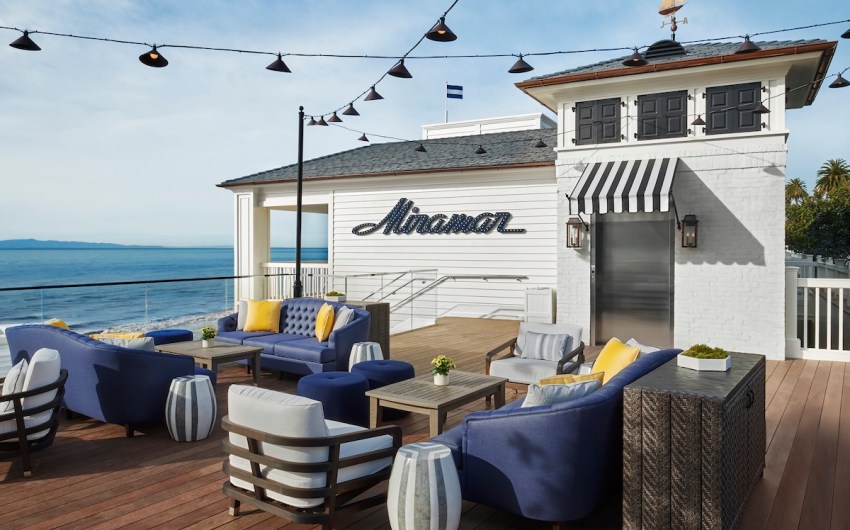The Big Question: ‘What’s Going On with La Cumbre Plaza?’
Santa Barbara Neighbor Walks Hosts Event Discussing Future of Redevelopment

Walking through La Cumbre Plaza on a Saturday morning feels like a quiet, private moment to yourself. Nothing but a cool breeze and sunshine falling through the awnings of deserted storefronts. And that’s the problem.
The once bustling mall (according to those who knew the days of Sears, Red Robin, Mrs. Field’s, and K·B Toys) on upper State Street is now a skeleton of its former self, with an uncoordinated assortment of pop-up shops, arts and crafts centers, upscale boutiques, and a church meeting hall.
This past Saturday morning, however, an unusually large crowd of more than 50 people huddled in front of La Cumbre’s Grace Fisher Foundation Clubhouse, ready for a walking tour through the mall, hosted by Santa Barbara Neighbor Walks and community historian Michael Montenegro, which intended to answer the big question on everyone’s mind: “What’s going on with La Cumbre Plaza?”
The event included a group of speakers who shed light on the proposed plans for a redevelopment of the Macy’s department store that could bring nearly 650 units of housing, including the project’s developer, Matt Taylor; City Councilmember Eric Friedman; and Rob Fredericks, director of the city’s Housing Authority.
Councilmember Friedman, who represents the northern parts of the city, including the upper State Street and the Samarkand areas, said that La Cumbre Plaza “has seen better days.”
“It’s really been in a hole,” he said. “I believe that it’s one of the places in the city where you can really make an effective change and bring in housing and revitalize the area.”

After the city rezoned the plaza to allow for residential use in 2013, the Taylor family purchased half of the property with plans to bring housing to the area. When an early proposal came in for 642 units of housing with 52 affordable units, Councilmember Friedman began to look for ways to work with the developers to address some of the concerns raised by the community regarding the number of affordable units and the potential impacts on the neighborhood and school district.
“This is the first domino in the whole redevelopment of the plaza,” Friedman said to the crowd during the first stop of the walking tour. “What happens with the Macy’s property will dictate what will happen to the mall.”
Just last week, the City Council unanimously went forward with a plan — introduced by Friedman and fellow councilmember Mike Jordan — allowing city staff to negotiate with the developers toward a term sheet that would sweeten the deal on both sides: the city could get a higher number of low- and moderate-income affordable units and other community benefits by promising incentives and the certainty of approval to the developers.
Friedman said during the walking tour that he hopes these talks will result in more diversity of income levels, “so we have a wide range of those living and working there.”
As the group made its way over to the Macy’s property, Taylor gave an update on the proposed design of the $250 million project, which he said will gradually step up from a “vaulted, one-story, live-work option” on State Street to taller, denser structures in the center, in a “wedding cake” effect, with the tallest structures reaching up to 74 feet — the same height as the current Macy’s tower. The project will be broken up into four buildings, he said, and six different structures.
“Instead of doing one large residential massing, which is typically what you’d see here, we’ve broken it up,” Taylor said. “It’s at great expense, but we think it creates the right project.”

While Taylor did not address the negotiations regarding a higher number of affordable units, he said that the rates required for Capital-A affordable units — “$1,200 for a studio at moderate income, and even less for low and very-low” — are “substantial losses for a market-rate developer to take.”
“I pay all the property taxes; I pay all the operating taxes; I pay everything,” Taylor said. “So there’s no break given to me for building those — I get an incentive for doing it.”
One thing Taylor mentioned that could help address the need for housing would be a partnership with the Chamber of Commerce for a “local preference,” which would allow “a very significant number of units” to be set aside for employees of businesses on the South Coast.
As the tour finished in front of the Grace Village Apartments across the parking lot, Fredericks explained how the senior-living complex was developed thanks to a land donation from Grace Lutheran Church in 2014. The church, which had seen declining membership, gave the organization the property in hopes of bringing affordable housing for seniors.
“When a congregation is willing to give you the land, which is very scarce in our community, you don’t look a gift horse in the mouth,” Fredericks said.
While the Grace Village project, the upcoming Grace Village II project, and others such as the 46-unit “family and special needs” housing on the way nearby at 15 South Hope Avenue are examples of what can happen with nonprofit developers like the Housing Authority, Fredericks said he understands that market-rate developers have other challenges to meet. His hope, he said, is that they would be willing to provide more than what is required by state law.
“They need to do a certain amount of market-rate development in their project to make it work,” Fredericks said. “What we try to advocate for all the time is: Can you get some more affordable? Do more than the minimums.”
Premier Events
Sat, Nov 30
11:00 AM
Santa Barbara
Mosaic Makers Market – Small Business Saturday
Thu, Dec 05
5:00 PM
Santa Barbara
First Thursday at Art & Soul in the Funk Zone
Thu, Nov 28
1:00 PM
Santa Barbara
The Cruisery Open on Thanksgiving
Fri, Nov 29
3:30 PM
Buellton
A Cowboy Christmas 2024
Fri, Nov 29
7:30 PM
Santa Barbara
Friendsgiving Country Night Black Friday
Sat, Nov 30
1:00 PM
Santa Barbara
Grateful Gathering-Live Dead & Jerry@The Brewhouse
Sat, Nov 30
1:00 PM
Santa Barbara
1st annual Funk Fest
Sat, Nov 30
9:30 PM
Santa Barbara
Numbskull Presents: The Cure & More DJ Night
Sun, Dec 01
5:00 PM
Santa Barbara
Paseo Nuevo Tree Lighting Ceremony
Fri, Dec 13
12:00 PM
Santa Barbara
Gem Faire
Fri, Dec 13
7:00 PM
Santa Barbara
SBHS 2024 Annual Fall Dance Recital
Sat, Nov 30 11:00 AM
Santa Barbara
Mosaic Makers Market – Small Business Saturday
Thu, Dec 05 5:00 PM
Santa Barbara
First Thursday at Art & Soul in the Funk Zone
Thu, Nov 28 1:00 PM
Santa Barbara
The Cruisery Open on Thanksgiving
Fri, Nov 29 3:30 PM
Buellton
A Cowboy Christmas 2024
Fri, Nov 29 7:30 PM
Santa Barbara
Friendsgiving Country Night Black Friday
Sat, Nov 30 1:00 PM
Santa Barbara
Grateful Gathering-Live Dead & Jerry@The Brewhouse
Sat, Nov 30 1:00 PM
Santa Barbara
1st annual Funk Fest
Sat, Nov 30 9:30 PM
Santa Barbara
Numbskull Presents: The Cure & More DJ Night
Sun, Dec 01 5:00 PM
Santa Barbara
Paseo Nuevo Tree Lighting Ceremony
Fri, Dec 13 12:00 PM
Santa Barbara
Gem Faire
Fri, Dec 13 7:00 PM
Santa Barbara























You must be logged in to post a comment.